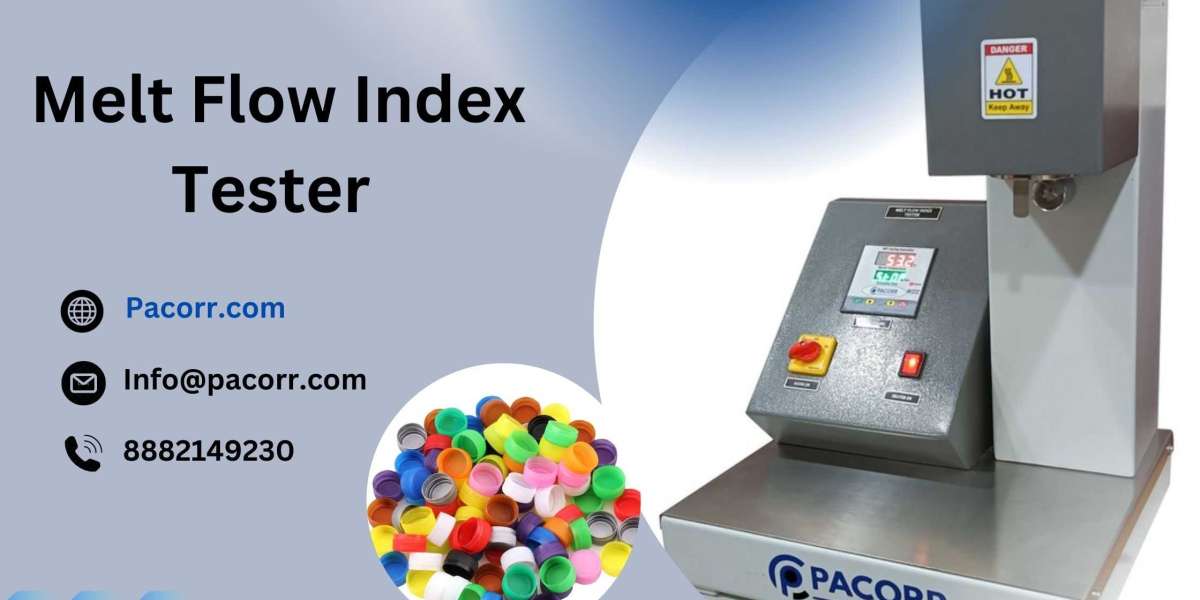What is a Melt Flow Index Tester?
A Melt Flow Index Tester is an instrument designed to measure the rate of extrusion of a thermoplastic polymer through a capillary of a specific diameter and length under a prescribed load. The test is performed by heating the polymer sample to a defined temperature and applying a known weight to push the material through the capillary. The amount of polymer extruded in ten minutes is recorded as the melt flow rate Melt Flow Index Tester.
Key Components of a Melt Flow Index Tester
- Barrel and Piston Assembly: The barrel is where the polymer is heated to the test temperature. The piston applies the load to the polymer, forcing it through the capillary.
- Capillary Die: A precisely machined die through which the polymer flows. The dimensions of the die are standardized to ensure consistent and repeatable results.
- Temperature Control System: Ensures the barrel maintains a constant temperature during the test, which is critical for accurate measurements.
- Load Weights: Different weights are used to apply varying levels of force on the polymer, depending on the material and test requirements.
- Cutting Device: Automatically cuts the extruded polymer at regular intervals to facilitate measurement.
Importance of Melt Flow Index Testing
The Melt Flow Index Tester Price is a critical parameter in polymer processing. It provides valuable information about the material's viscosity and flow characteristics, which can affect the processing behavior and end-use properties of the polymer. Here are some key reasons why MFI testing is important:
- Quality Control: Ensures consistency in the production process by monitoring the flow properties of raw materials.
- Material Specification: Helps in selecting the appropriate polymer grade for specific applications by comparing the MFI values.
- Process Optimization: Assists in optimizing processing conditions such as temperature and pressure during molding and extrusion processes.
- Regulatory Compliance: Ensures that the materials meet industry standards and regulatory requirements.
Applications of Melt Flow Index Testing
Melt Flow Teste is widely used across various industries where thermoplastic polymers are utilized. Some of the common applications include:
- Injection Molding: Determines the suitability of a polymer for injection molding processes by assessing its flow behavior under different conditions.
- Extrusion: Ensures that the polymer will flow consistently through the extrusion die, leading to uniform product dimensions and properties.
- Blow Molding: Helps in selecting materials with appropriate flow characteristics for blow molding applications, such as producing bottles and containers.
- Film and Sheet Production: Assists in choosing polymers that will produce films and sheets with desired thickness and mechanical properties.
Operating the Melt Flow Index Tester
Operating a Melt Flow Index Testing involves several steps to ensure accurate and reliable results. Here’s a brief overview of the procedure:
- Sample Preparation: The polymer sample is cut into small pieces and weighed accurately.
- Heating: The barrel is preheated to the specified temperature for the test.
- Loading: The sample is placed in the barrel, and the piston is inserted.
- Testing: The weight is applied to the piston, and the polymer is extruded through the capillary. The extrudate is collected and measured over a set period.
- Calculation: The weight of the extrudate is used to calculate the melt flow rate (MFR), expressed in grams per ten minutes (g/10 min).
Choosing the Right Melt Flow Index Tester
When selecting a Melt Flow Index Tester, several factors should be considered:
- Accuracy and Precision: Ensure the tester provides consistent and repeatable results.
- Temperature Range: Choose a tester that can operate within the required temperature range for your materials.
- Load Options: Ensure the tester can apply the necessary loads for different polymers.
- Ease of Use: Look for features such as digital displays, automated cutting devices, and user-friendly interfaces.
Conclusion
The Melt Flow Index Tester is an indispensable tool for anyone working with thermoplastic polymers. It provides critical insights into the material's flow properties, helping manufacturers maintain quality control, optimize processing conditions, and meet industry standards. Investing in a reliable and accurate MFI tester is essential for ensuring the consistent performance and quality of plastic products.
For more information on Melt Flow Index Testers and other quality control instruments, visit Pacorr.com.
FAQ: Melt Flow Index Tester
- What is a Melt Flow Index Tester?
A Melt Flow Index Tester is a device used to measure the flow rate of thermoplastic polymers when subjected to a specified temperature and load. This helps in determining the material's viscosity and flow characteristics, which are crucial for various plastic processing applications.
- How does a Melt Flow Index Tester work?
The tester works by heating a polymer sample to a defined temperature and then applying a specified load to push the material through a capillary die. The amount of polymer extruded in ten minutes is measured and recorded as the melt flow rate Melt Flow Index Tester Price or melt flow index (MFI).
- Why is Melt Flow Index testing important?
MFI testing is essential for quality control, material specification, process optimization, and regulatory compliance. It ensures that the polymer materials used in manufacturing processes meet the required flow properties for consistent product quality.
- What industries use Melt Flow Index Testers?
MFI Testers are used across various industries, including injection molding, extrusion, blow molding, and film and sheet production. Any industry that processes thermoplastic polymers can benefit from MFI testing.
- What are the key components of a Melt Flow Index Tester?
Key components include the barrel and piston assembly, capillary die, temperature control system, load weights, and cutting device. These components work together to ensure accurate and repeatable measurement of the melt flow rate.
- How do you operate a Melt Flow Index Tester?
The operation involves preparing the polymer sample, preheating the barrel, loading the sample, applying the weight, and measuring the extruded polymer. The weight of the extrudate is then used to calculate the melt flow rate.
- What factors should be considered when choosing a Melt Flow Index Tester?
Consider accuracy and precision, temperature range, load options, and ease of use. Features like digital displays, automated cutting devices, and user-friendly interfaces can enhance the testing process.
- Can the Melt Flow Index Tester be used for all types of polymers?
MFI Testers are designed for thermoplastic polymers. It's important to ensure that the tester you choose can handle the specific types of polymers you work with, considering the required temperature and load ranges.
- How is the Melt Flow Index calculated?
The Melt Flow Index Testing is calculated by measuring the weight of the polymer extruded through the capillary die over a set period (usually ten minutes) and then expressing this weight in grams per ten minutes (g/10 min).
- What standards govern Melt Flow Index testing?
MFI testing is governed by international standards such as ASTM D1238 and ISO 1133. These standards define the test conditions, procedures, and equipment specifications to ensure consistent and reliable results.
- What maintenance is required for a Melt Flow Index Tester?
Regular maintenance includes cleaning the barrel and capillary die, calibrating the temperature control system, and checking the weights and piston for wear. Proper maintenance ensures accurate and reliable test results.
- How does MFI testing help in process optimization?
By understanding the flow properties of polymers, manufacturers can optimize processing conditions like temperature and pressure during molding and extrusion. This leads to improved product quality and reduced material waste.
For more information and to explore our range of Melt Flow Index Testers, visit Pacorr.com.








